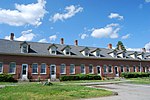Five Mile River

The Five Mile River is a 23.5-mile-long (37.8 km) river located in Connecticut's northeast corner which flows through the towns of Thompson, Putnam, and Killingly. The original Nipmuc name was Assawaga, meaning "place between" or "halfway place". The Assawaga received its English name from the fact that the first land laid out upon it was "supposed to be about five miles from" Woodstock, Connecticut. The Five Mile is a tributary of the Quinebaug River and is part of the Thames River watershed. Its source is Little Pond (also known as Schoolhouse Pond), close to the Massachusetts border. It empties into the Quinebaug River at Danielson, near the intersection of Connecticut Route 12 and U.S. Route 6. The Five Mile River has several dams, most of which are remnants of defunct mills and some of which are still used by local industry. Its largest impoundment is Quaddick Reservoir. The best examples of surviving mill villages are Killingly in villages such as Pineville, Ballouville, Attawaugan, and Dayville.
Excerpt from the Wikipedia article Five Mile River (License: CC BY-SA 3.0, Authors, Images).Five Mile River
North Street,
Geographical coordinates (GPS) Address Nearby Places Show on map
Geographical coordinates (GPS)
| Latitude | Longitude |
|---|---|
| N 41.818961 ° | E -71.88776 ° |
Address
North Street
North Street
06239 , Danielson
Connecticut, United States
Open on Google Maps








